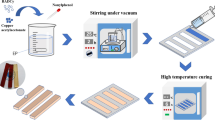Abstract
Epoxy molding compound (EMC) has been widely used as a main material for encapsulation and protection of semiconductor packages because of its low cost, high moisture resistance, high heat resistance, and good mechanical performance. Due to the extensive application of lead-free solder in place of Sn-Pb, soldering temperature is higher than before; this demands that EMC, which is usually used for lead-free solder, should have extremely low thermal stress and excellent stability at elevated temperatures. In this work, 1,3-propanediol bis(4-aminobenzoate) (PBA) was added to an EMC product to form a novel epoxy molding compound (FEMC). PBA had very limited effect on the process feasibility of EMC, and caused reduction of the storage modulus by 40% to 50% at high temperatures and reduction of the glass-transition temperature by more than 10°C, which are very helpful to reduce thermal stress buildup during high-temperature soldering processes. The increases of the tab pull force of copper- and silver-plated lead frames within EMC due to PBA were up to 58% and 117%, respectively. With increasing PBA content in the EMC, water absorption increased in a linear fashion, so the amount of PBA added to the EMC should be limited, preferably to not more than 1%.
Similar content being viewed by others
References
Lu Daniel and C.P. Wong, Materials for Advanced Packaging (New York: Springer, 2008), p. 339.
Yoshinobu Nakamura, Shinjrou Uenishi, Teruo Kunishi, Kazuyuki, Haruo Tabata, Kazuyuki Kuwada, Hideto Suzuki, and Stsunetaka Matsumoto, IEEE Trans. Compon. Hybrid Manuf. Technol. 10, 502 (1987).
M. Variyam, V. Sundararaman, K. Sitaraman Suresh, Wu Jiali, R.T. Pike, and C.P. Wong, IEEE Trans. Electron. Packag. Manuf. 22, 290 (1999).
Myung-Jin Yim, Young-Doo Jeon, and Kyung-Wook Paik, IEEE Trans. Electron Packag. Manuf. 23, 171 (2000).
M. Kakei, Y. Ikeda, and S. Koshiba, Nikkei Electron. Nikkei Micro Device 6, 82 (1984).
K. Kuwata, K. Iko, and H. Tabata, IEEE Trans. Compon. Hybrid Manuf. Technol. 8, 486 (1985).
F. Shoraka, K. Kinsman, B. Natarajan, and C. Cealer, 6th Annu. Int. Electron. Pack. Conf., San Diego (1986), p. 294.
Sutapa Ghosh and N. Krishnamurti, Eur. Polym. J. 36, 2125 (2000).
Hongjie Sun, Haitao Huo, Hao Nie, Shiyong Yang, and Lin Fan, Eur. Polym. J. 45, 1169 (2009).
Wenbin Liu, Qihao Qiu, Jun Wang, Zichun Huo, and He Sun, Polymer 49, 4399 (2008).
C. Fu, S. Chen, P. Berggren, Q. Fan, and W. Du, 10th Int. Symp. Adv. Packag. Mater.: Microtech., Cambridge (2010), p. 29.
L. Xu, X. Lu, J. Liu, X. Du, Y. Zhang, and Z. Cheng, 10th Int. Conf. Electron. Packag. Technol. High Density Packag., Peking, China (2009), p. 1039.
X. Lu, L. Xu, H. Lai, X. Du, J. Liu, and Z. Cheng, 10th Int. Conf. Electron. Packag. Technol. High Density Packag., Peking, China (2009), p. 1051.
Author information
Authors and Affiliations
Corresponding author
Rights and permissions
About this article
Cite this article
Cui, Hw., Li, Ds. & Fan, Q. Preparation and Characterization of a Novel Epoxy Molding Compound with Low Storage Modulus at High Temperature and Low Glass-Transition Temperature. J. Electron. Mater. 41, 2599–2605 (2012). https://doi.org/10.1007/s11664-012-2105-7
Received:
Accepted:
Published:
Issue Date:
DOI: https://doi.org/10.1007/s11664-012-2105-7




